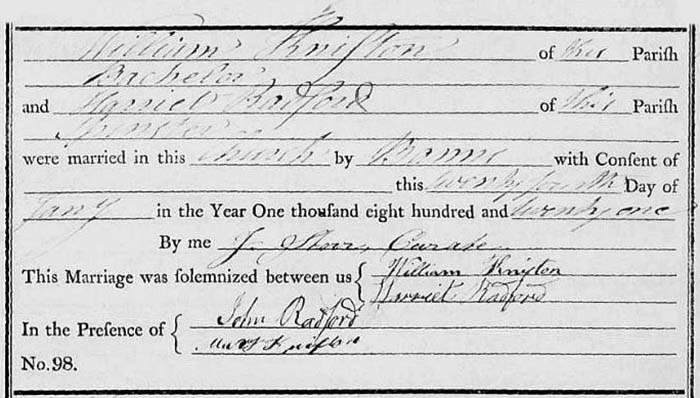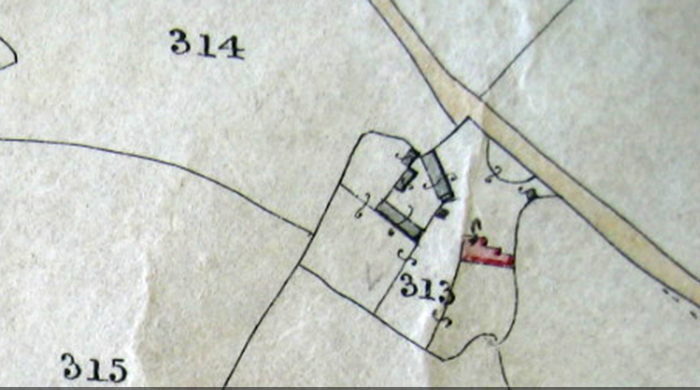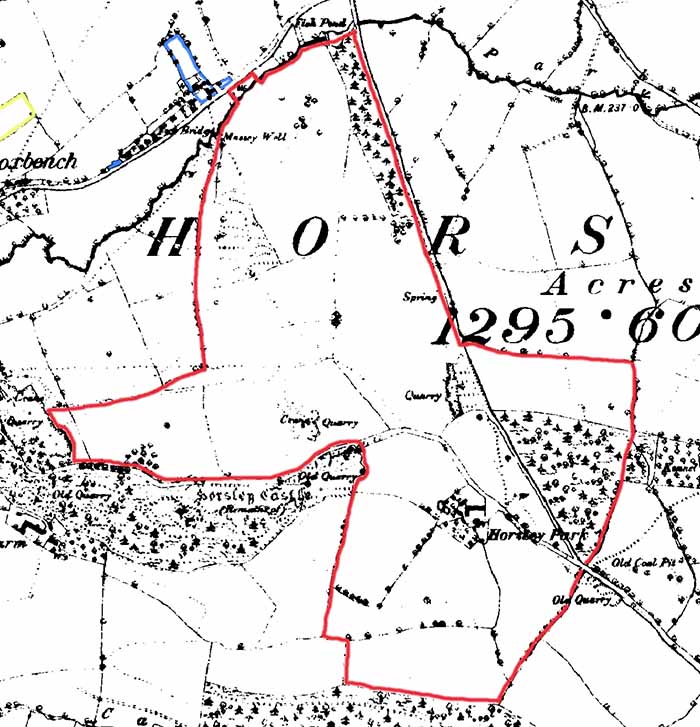William Knifton, the son of Thomas Knifton and his wife and Ann, was baptised on 12th February 1795 at St Clement’s Church in Horsley, Derbyshire. The family lived at what was then called Tantin Cross, or St Anthony’s Cross, which is now part of Coxbench.
On 27th March 1815, William witnessed the marriage of his sister Elizabeth to John Hollingworth at St Alkmund’s Church, Derby, and on 25th December 1820, he witnessed the marriage of his brother John to Antoniette Holmes at St Clement’s Church.
William married Harriet Radford on 24th January 1821 at St Clement’s Church. Their marriage was witnessed by Harriet’s brother John, and Mary Knifton - this may have been William’s sister Mary who later married John Radford, although while she signed her name as Mary in witnessing William’s marriage, she signed with ‘her mark’ at her own marriage.

Harriet was born in 1803, the daughter of John and Anne Radford. She was baptised on 6th March 1803 at the St Mary the Virgin’s Church, Denby.
William was a farmer and after their marriage he lived with Harriet at Horsley Park in Coxbench.
On 24th April 1821, William and his sister Sarah witnessed the marriage of their sister Millicent to Francis Walker at St Clement’s Church.
William and Harriet had their first child Curtis baptised on 30th August 1822 at Horsley Church.
On 26th May 1823, William was a witness at the marriage of his sister Mary to John Radford, Harriet’s brother.
William and Harriet’s next child was named Eliza, who was baptised on 28th May 1825. She was followed by Thirza, who was baptised on 18th October 1827, and Anne, who was baptised on 11th April 1830. The baptisms were at St Clement’s Church, Horsley.
William was widowed in September 1832 and Curtis, Eliza, Thirza and Ann lost their mother. Harriet was buried in the churchyard at Horsley on 19th September. She was 29 years old.
William appears to have moved to Derby between 1832 and 1838, perhaps leaving his son Curtis to run the farm.
Banns of marriage were read at St Peter’s Church, Derby, ‘between William Knifton and Mary Ann Holmes, both of this parish’ on Sunday 11th, 18th and 25th March 1838. They were married at St Peter’s Church on 6th April 1838. The address for both William and Mary was given as St James’ Lane, and oddly the marriage record states that William was a labourer, rather than a farmer. The occupation of William’s father is also incorrectly stated. Perhaps they were trying to conceal their true identity since Mary was seven months pregnant. Mary Ann was a spinster, the daughter of Thomas Holmes.

William and Mary Ann’s first child, Enoch, was baptised on 24th June 1838 at Horsley.
At the time of the April 1841 census, William and Mary Ann were living at Horsley Park Farm together with their son Enoch and William’s children from his first marriage, Curtis, Eliza, Thirza and Anne. Their second child, Harriet, was baptised on 20th February 1842.
 Horsley Park farm shown on the 1844 Tithe map
Horsley Park farm shown on the 1844 Tithe map
Horsley Park Farm was an extensive property. The tithe survey of 1844 records that William occupied 126 acres, two roods and eight perches of meadow, pasture, and arable land, rented from Edward Degge Sitwell. The ‘house homestead etc.’ is described as being of one acre and one rood in size. The arable land William occupied is described as ‘Nether park and part of Daffodilly piece, Little park and part of Daffodilly piece, Buckstone Close (of 12 acres), Big park, Over Park, Intake, Long Close and Top of Rough’. The meadow and pasture land which he occupied is described as ‘Part of old hills, Rough Corner, Graces garden and part of old hills, Alder close and plantation (of 8 acres), Old Cow Pasture, Step Close, Orchard Close, Sandy hill and Quarry close’. William also occupied a garden and another ‘plantation’. Tithes of £4 3s. 4d were payable to the vicar, and £14 13s. 1d to the impropriator.
 The area outlined in red was farmed by William Knifton in 1844
The area outlined in red was farmed by William Knifton in 1844
William and Mary’s third child, Sarah, was born in December 1845 and baptised at St Clement’s Church on 8th February 1846. However, Sarah died when she was 10 months old and was buried on 28th October in the churchyard at Horsley.
An entry in the diary of Thomas Needham, a local resident of Horsley, reads ‘Mr Matthew Abbott fetched his new double shafted waggon from Wm. Knifton’s shop at Horsley on the 10th day of July 1847, made by William Walters’.
William and Mary’s next child, William, was baptised on 24th October 1847 at Horsley. In later life William emigrated to Australia, but died during a trip back while visiting family in Derbyshire.
The 1851 census was taken on Sunday 30th March 1851. This was also the day that William and Mary had their fifth child Mary baptised at St Clement’s Church. She was two months old. The census return shows that William was a farmer of 100 acres, employing two agricultural labourers. Also at the house was William’s daughter Ann, and William and Mary’s children Enoch, Harriet, William, and Mary. A local history book mentions that ‘at the top of the Old Hills was Horsley Park Farm; 100 acres farmed by William Knifton in 1851 (the Knifton’s were an old Horsley family).’ 1
Thomas Needham’s diary records that ‘Mary Ann Knifton the wife of William Knifton died on the 25th day of April 1854 aged 38.’ She was buried in the churchyard at Horsley on 28th April. Mary may have died during or shortly after child birth since the Horsley parish register records on 30th May 1854 the baptism of Sarah ‘daughter of William and Mary Anne Knifton’ of Horsley Park. William and Mary gave their last child the same name as their only child that had died in infancy.
In 1856, the Derby Mercury reported that ‘a few friends of Mr John Radford, of Smalley, conversed upon the subject of presenting that gentleman with a testimonial as a token of gratitude for public services rendered as a justice of the peace’. It was reported that others in the local community also wanted to show their appreciation, so it was decided to receive subscriptions ‘limited to two guineas’ to pay for a portrait for which Mr Radford would sit ‘to Eddis, of London’. The list of subscribers was published in the Derby Mercury and included William and his nephew Thomas who, like most people, contributed 10s. 6d. each. The portrait was presented to John Radford on 21st October 1856 at an event in Smalley, which William and Thomas may have attended. An account of the event was recorded by Joseph Moss in his diary:
‘The nobility and gentry of the county of Derby having raised a subscription for the purpose of presenting to J. Radford Esq. a small tribute of their testimony and regard as an active and vigilant Magistrate. A committee having been formed, it was agreed that a portrait executed by an eminent artist to be the most suitable. Accordingly a pavilion was erected near Smalley Hall and the subscribers assembled and partook of a cold collation served by Mrs Cantbill of the Royal Hotel, Derby. After the cloth had been removed the chair was taken by J.W. Evans Esq. and the usual loyal toasts were given. The Chairman then addressed the meeting and presented the portrait and Mr Radford made a suitable reply. Several other speeches were given and the utmost glee and good humour prevailed. The thanks of the Chairman being given and responded to, that gentleman left the chair and the portrait was removed to its future destination. The music in attendance played at intervals. At last a dance was proposed but the committee rejected it and high words ensued amongst some of the parties, and what was all pleasant and cheerful in a few minutes became gloomy and dull. The company soon separated and some of them in not very good humour.’
Pictures of the portrait by Eden Upton Eddis can be found on the internet.
 White’s 1857 Directory of Derbyshire | Horsley Township
White’s 1857 Directory of Derbyshire | Horsley Township‘Those marked 2 reside in the Park’
William Knifton died on 26th January 1858. Thomas Needham noted in his diary ‘William Knifton of the park died on the 26th day of January 1858 Aged 62 years and 11 month.’ William was buried in the churchyard at St Clement’s Church, Horsley, on 30th January.
In total William had a family of ten children; four with his first wife Harriet, and six with his second wife Mary Ann. When he died in 1858, three of his children were under 10 years of age; William aged 9, Mary aged 7, and Sarah aged 3. William’s oldest son Curtis was married and living at Hulland Ward so William’s son Enoch, then aged 19, brought up his younger siblings.
In his Last Will and Testament written on 26th July 1857, William described himself as being a ‘farmer and living at Horsley Park in the Parish of Horsley’. He prescribed in his Will that when his daughter Sarah reached the age of 21 (which would be in 1875), ‘my son Curtis and daughters Eliza, Thirza and Ann receive...one hundred pounds to be equally divided between them’ and that ‘my daughters Harriet, Mary and Sarah receive at the same time one hundred pounds to be equally divided between them’. He also said that ‘I devise that my son William shall have liberty to choose a trade when he is fourteen years old [which would be in 1861] and that he be provided with reasonable clothes during his apprenticeship but should he choose to remain with his brother to receive wages as they may agree and when my daughter Sarah shall be twenty one he shall receive one hundred pounds from his brother Enoch’.
William also left in trust to Robert Walker, the husband of his daughter Eliza, ‘two hundred Pounds to pay the legacies to that amount first named he paying my son Enoch the interest of it to assist him in bringing up the young children until the time appointed to pay it’. William bequeathed ‘the possession of the place so long as the Landlord may think well together with the whole of the stock and the remainder of my property of whatever kind and wherever situate unto my son Enoch subject to him paying and receiving all my just debts and to the control of his brother in law Robert Walker so far as seeing that the true intent of this Will be carried out’. William’s Will was proved on 23rd March 1858 at Derby with effects valued at under £600.
William and Harriet Knifton were my great-great-great-grandparents.
1 A. Webster, Horsley Through the Ages: A Derbyshire Village (Oldrini, 1998).